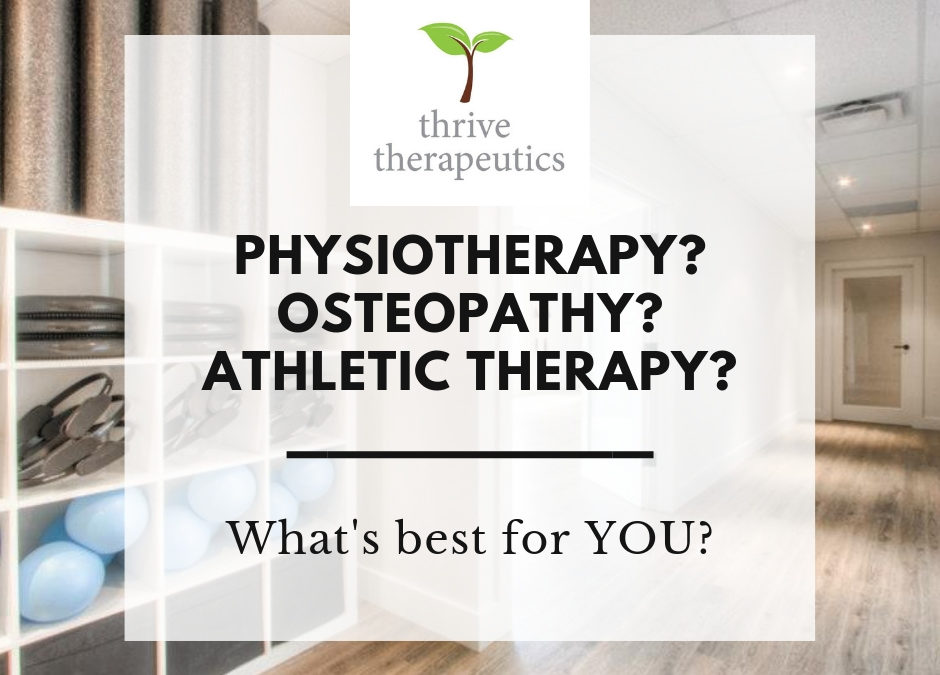
A very common question we are asked at the clinic is what IS the difference between the 3 types of therapies we offer here. It is a little bit tricky to answer, that’s for sure. The three modalities definitely overlap in training and what conditions they treat. Read on for a description of each individual therapy.
Physiotherapy
The heart of the physiotherapy profession is the understanding of how and why movement and function take place. Physiotherapists are highly skilled and autonomous health professionals who provide safe, quality client-centred physiotherapy through a commitment to service availability, accessibility and excellence.
Physiotherapists are considered to be primary health care practitioners. This means we are able to diagnose and treat conditions within our scope of practice. Physiotherapy, as a profession, is very much aligned with the traditional medical model. We are taught extensively in anatomy, physiology, and pathology.
Training for physiotherapy is currently at a Master’s level of education. Physiotherapists must pass a national standardized competency examination before licensing with the Ontario College of Physiotherapists.
Recently two health economists outlined 13 conditions which scientific evidence has shown physiotherapy is integral in management and treatment. The ones relevant to Thrive Therapeutics are:
- management of chronic disease – arthritis, autoimmune, pain, diabetes, amongst other conditions
- joint arthroplasty (joint replacements)
- low back pain
- musculoskeletal conditions
- pediatrics
- strokes and other neurological conditions
- prevention of falls
- pelvic floor
- vestibular rehabilitation
Physiotherapy interventions are very broad. Treatment definitely includes education, therapeutic exercises, and manual therapy. Manual therapy include soft tissue techniques, joint mobilizations, acupuncture, and/or massage… just to name a few!
Why Choose Physiotherapy: acute and chronic pain, rehabilitation, neurological conditions, senior’s preventative care, balance issues, pediatric musculoskeletal and neurological management, and others!
Osteopathy
Osteopathy is a client-centred discipline that is based on understanding the relationship between structure and function in order to enhance the body’s inherent ability to heal. It relies on skilled manual therapeutic techniques to assess and treat the client, guiding the natural self-healing properties of the human body.
At this clinic, our practitioners are Osteopathic Manual Practitioners, trained at the Canadian College of Osteopathy (CCO). The training at this school is very extensive. All students here are required to have had already a manual therapy designation which includes physiotherapy, massage therapy, or other professional designations. The program itself is 5 years in length. At the end of the academic portion, the students are required to pass a competency examination. Following which, we are the required to complete and present a thesis before getting our full designation of D.O.M.P.
Techniques of osteopathy include soft tissue manipulation, osteopathic articular technique, cranial osteopathy, and visceral manipulation. Although many of these techniques are used in other professions, what makes osteopathy unique is the philosophy of treating the body as a whole.
Why Choose Osteopathy: postural problems, acute or chronic pain, muscle spasms, respiratory difficulties, digestive issues, pre- and post- natal care, baby feeding issues, and many more!
Athletic Therapy
Athletic therapists are extensively trained to assess and treat dysfunctions in the musculoskeletal system, as it relates to the pursuit of any physical activity.
A Certified Athletic Therapist (CAT) completes a 4-year degree program at a recognized University program. Their education emphasizes exercise physiology, biomechanics, and basic emergency care. In order to be certified, they must also pass a national competency examination.
An athletic therapist utilizes contemporary rehabilitation techniques, therapeutic modalities, physical reconditioning and supportive strapping procedures to promote optimal healing and prepares the individual for safe reintegration into an active lifestyle.
Why Choose Athletic Therapy: movement dysfunction creating pain, acute musculoskeletal injuries, athletic injuries, getting back to exercising, progressive exercise programs, prevention exercise programs
Which One Do YOU Choose?
As you can see from the descriptions, all 3 professions treat similar conditions and situations. All 3 involve manual therapy, education, and therapeutic exercises.
Many of our therapists here at Thrive Therapeutics are dual trained, which means they have more than one professional designation.
Give us a call today and get started!
